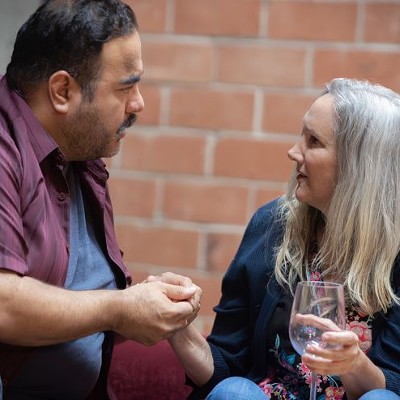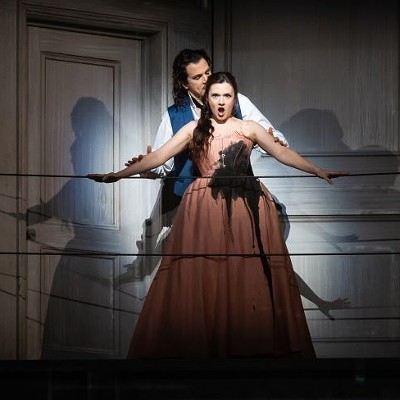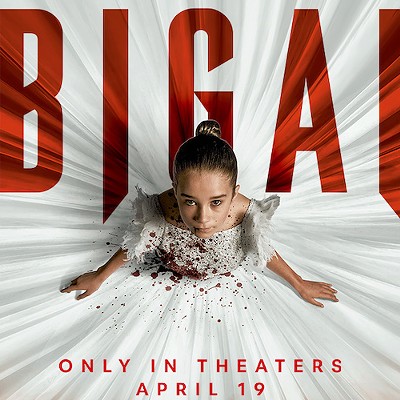For his fourth solo exhibition at Inman Gallery, Israeli-born Gilad Efrat, who lives and works in Tel Aviv, continues to challenge himself as a painter. In his earlier works he perfected the art of producing fluid representations of the expansive desert landscape, veering towards cooler browns and tans. Evolving from there, Efrat invoked the grid technique to create highly detailed architectural images from photographic references, adding warping as if to demonstrate heat rising from the desert.
His current exhibit, "Sandwalk", was named for Charles Darwin's famous thinking path, which provided the English biologist a regimented routine for channeling deeper thoughts. This focus on pattern and movement has resulted in two very different pieces in the show, but with a newer direction toward deeper, bolder color.
The red version of Darwin Thinking Path is linear, with horizontal and vertical movement, and demonstrates the artist's skill at applying thick paint over base layers and scraping away small and large areas with a frenetic energy. From a distance one sees the possibility of tree trunks against a setting sun and its reflection on the desert landscape. Up close, one finds small explosions, objects in flight, architectural forms and an urgent intensity.
The mixing of United Nations blue to his charcoal and lighter grays in the blue version of Darwin Thinking Path almost seems as if Efrat has jumped out of the desert and into the Mediterranean Sea, albeit one teeming with submarines, migratory birds and secretive symbols.
Survival in the desert is its own form of natural selection, and a great example is the Tamarisk tree found in the Negev desert, which has adapted to the arid conditions and can survive in high saline environments. Efrat's three pieces - Tamarisk (Negev) and two named Tamarisk Negev - are all brightly colored adaptations of this sturdy plant, rendered with heat, movement and intensely detailed texture. One of the pieces, against a muted blue gray background, evokes images of the burning bush, with its ability to simultaneously be on fire yet not be destroyed by the sacred light. Tamarisk (Negev) calls on colors traditionally found in the '70s - harvest gold, avocado green and neon orange - but the resulting landscape is modern, fresh and highly interpretive.
Ktzi'ot Prison on the Moon (Negev) serves as a bridge between the artist's previous linear works and his current experiments with color. His portrayal of the 99-acre Ansar detention camp, veiled in secrecy, is rendered in cool, barren grays. He has scraped away the paint to emulate barbed wire, and painted the expansive desert outside with verdant greens, as if to hold hope for the promise of freedom.
Also on display in the South Gallery, returning artist Brad Tucker's Wobbles exhibit shows the results of recent experimentation with window screens and silkscreen techniques, overlapped and rotated, with a common wavy edge and paying homage to this Austin-based skateboarder's hobby.
Sandwalk and Wobbles continue through April 4, at Inman Gallery, 3901 Main, open Tuesday to Saturday, 11 a.m. to 6 p.m., 713-526-7800, inmangallery.com.






